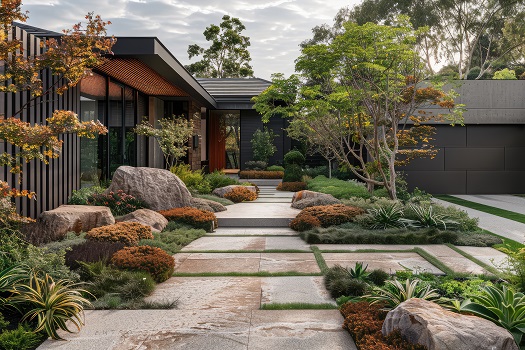Unknown Facts About Hilton Head Landscapes
Table of ContentsThe Of Hilton Head LandscapesNot known Facts About Hilton Head LandscapesAll About Hilton Head LandscapesHilton Head Landscapes - An OverviewThe Greatest Guide To Hilton Head LandscapesHilton Head Landscapes Can Be Fun For EveryoneThe smart Trick of Hilton Head Landscapes That Nobody is Talking About
Line creates all kinds and patterns and can be utilized in a variety of methods the landscape. Line in the landscape is developed by the edge in between 2 materials, the overview or shape of a type, or a long straight function. Lines are an effective device for the designer because they can be made use of to create a limitless variety of forms and types, and they control activity of the eye and the body.

Lines can have one or even more features, such as those defined listed below, but they generally offer various purposes. Number 1. Lines in the landscape - landscape design hilton head. The residential properties of lines identify just how individuals react to the landscape, both psychologically and literally. Straight lines are architectural and strong; they develop a formal character, are usually related to a symmetrical layout, and lead the eye directly to a centerpiece.
The Definitive Guide to Hilton Head Landscapes
Straight lines are most commonly found in hardscape edges and material. Rounded lines develop an informal, natural, kicked back character that is connected extra with nature and asymmetrical equilibrium. Bent lines relocate the eye at a slower rate and add mystery to the space by creating covert views. Vertical lines move the eye up, making a space feel bigger.
Upright lines in the landscape consist of high, narrow plant material, such as trees, or tall frameworks, such as an arbor or a bird residence on a post. Straight lines relocate the eye along the ground plane and can make a space really feel bigger. Low lines are extra restrained and develop a feeling of rest or repose.
A Biased View of Hilton Head Landscapes
Lines are also produced by the upright forms of developed attributes and plant material. There are 3 key line types that develop kind in the landscape: bedlines, hardscape lines, and plant lines.
Bedlines connect plant product to the house and hardscape since the eye follows the line, moving the stare through the landscape. Hardscape lines are produced by the side of the hardscape, which marks the built structure. Line can additionally be developed by lengthy and narrow materials, such as a fencing or wall surface.
Getting My Hilton Head Landscapes To Work
Kind is located in both hardscape and plants, and it is usually the leading visual element that spatially organizes the landscape and typically figures out the design of the yard. The type of structures, plant beds, and garden ornaments also determines the overall form theme of the yard. Official, geometric kinds consist of circles, squares, and polygons.
Plants produce form in the garden via their lays out or silhouettes, yet kind can likewise be defined by a void or negative room in between plants - landscaping hilton head sc (https://h1tnhdlndscps.start.page). Circles can be cycles, or they can be divided right into half circles or circle segments and incorporated with lines to produce arcs and tangents
What Does Hilton Head Landscapes Mean?
Circles can likewise be extended into ovals and ellipses for even more variety and rate of interest. Circles are a strong style form since the eye is always drawn to the facility, which can be used to stress a centerpiece or link other types. Number 2. Circular types in hardscape and grass panels.
The square type can additionally be segmented and secondhand consistently to develop a grid pattern. Unlike circles, squares are more powerful on the edges, which can be lined up or overlapped to produce one-of-a-kind patterns and more complex types. Polygons are many-sided types with straight sides. Triangulars, for example, are three-sided polygons.
Twisting lines often simulate the all-natural training course of rivers or streams and can be referred to as smooth lines with deeply rounded wavinesses. Meandering lines (Figure 3) work well for pathways, plant bedlines, and dry stream beds. Meandering lines can add rate of interest and secret to a garden by leading customers around corners to find new views and spaces.
Indicators on Hilton Head Landscapes You Should Know

Number 5. Fragmented sides: stepping rocks in path. Type is the most long-lasting top quality of a plant (Landscapers near me). https://hearthis.at/steven-gonzales/set/hilton-head-landscapes/. Usual plant kinds are well established and standardized, as form is one of the most constant and recognizable feature of plants. Kind can also be developed with the massing of plants, where the overall mass creates a various form than a specific plant.
An extremely contrasting type must be made use of with careone or two job well as a prime focus, yet way too many create mayhem. All-natural plant forms, as opposed to over-trimmed forms, must establish the bulk of the make-up. The significance of total form is a lot more or less reliant on the seeing perspectivethe kind of a tree can show up quite Discover More Here various to a person standing under the cover versus checking out the tree from a range in an open area.
Some Known Facts About Hilton Head Landscapes.
Plant types additionally create and define the space or open areas in between the plants, developing either convex or concave forms in the spaces. High-arching tree branches generally develop a concave open room under the branches, and a rounded cover with reduced branches loads the room to produce a convex kind outdoors room under the tree.
